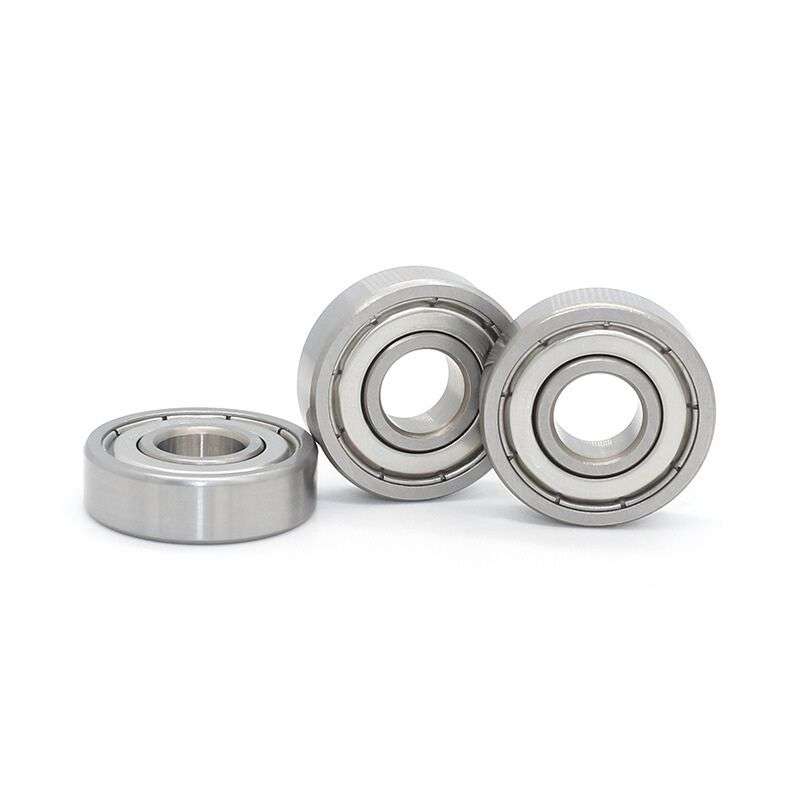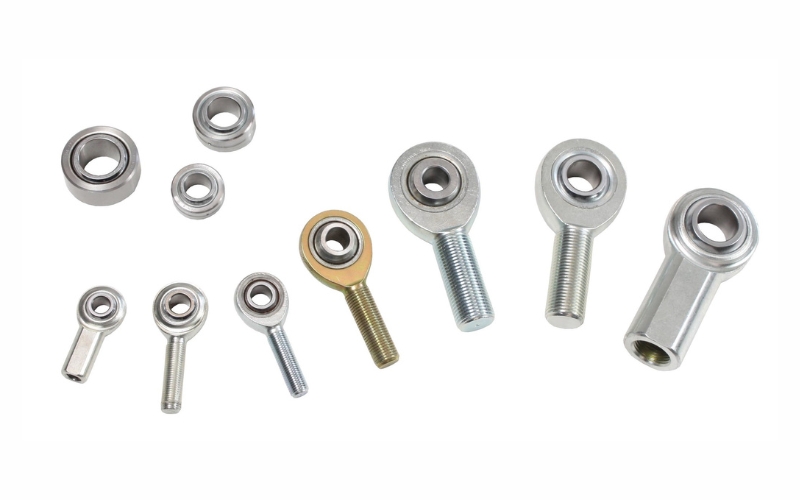Precision Engineering with Angular Bearings

Table of Contents
The Crucial Role of Angular Contact Bearings
In the world of machinery and mechanical systems, precision is often the key to exceptional performance. Angular contact bearings, with their specialized design and construction, play a pivotal role in achieving and maintaining this precision. These bearings are more than just components within a machine; they are the unsung heroes that enable machinery to operate smoothly and efficiently.
Angular contact bearings are engineered to handle complex loads, where both radial and axial forces come into play at specific angles. This unique design feature enables them to effectively manage thrust and radial loads simultaneously. In essence, they are the silent powerhouses ensuring the smooth functioning of numerous mechanical applications.
Understanding Angular Contact Bearings
What Are Angular Contact Bearings?
Angular contact bearings, often referred to as angular ball bearings, are a distinct category of ball bearings designed to tackle combined loads. Unlike standard radial bearings, angular contact bearings are purpose-built to handle the dynamic and diverse forces present in machinery. These bearings are characterized by their 45-degree contact angle between the inner and outer raceways, which allows them to support both axial and radial loads with remarkable efficiency.
Types of Angular Contact Bearings
Angular contact bearings come in various configurations, each tailored to meet specific load-carrying and speed requirements. Single-row angular contact bearings are the most common type, known for their versatility and widespread use. Double-row angular contact bearings provide enhanced load capacity, while four-point contact bearings are adept at handling radial and axial loads with minimal friction.
Benefits of Angular Bearings
Angular contact bearings offer a myriad of advantages that make them indispensable in the world of precision engineering. Their unique design features result in increased rigidity, reduced friction, and enhanced load-carrying capacity. These characteristics collectively elevate their significance in applications where precision and peak performance are paramount.
The Design and Structure
Anatomy of Angular Bearings
The anatomy of angular contact bearings is fascinating in its intricacy. It starts with the 45-degree contact angle mentioned earlier, which ensures the efficient distribution of axial and radial loads. Furthermore, these bearings typically consist of inner and outer raceways, a cage to separate the balls, and the balls themselves. The materials used in their construction, such as high-quality steel or ceramics, are chosen for their exceptional durability and performance characteristics.
Material Selection for Precision
The choice of materials for angular contact bearings is a critical factor in precision engineering. Manufacturers select materials known for their strength, durability, and resistance to wear and tear. High-grade steel is often used for its exceptional properties, including high tensile strength and corrosion resistance. In some specialized applications, ceramic materials are employed due to their lightweight and non-conductive properties.
Precision in Manufacturing Processes
The production of angular contact bearings demands a level of precision that few other industries can match. The manufacturing process involves a series of meticulous steps, including precision machining, heat treatment, and exacting assembly techniques. These steps ensure that each bearing adheres to stringent industry standards, maintaining the highest levels of accuracy and consistency.
Applications Across Industries
Automotive Advancements
The automotive industry is a prime example of an area where precision engineering, especially the use of angular contact bearings, has yielded significant advancements. In vehicles, these bearings find their place in critical components like wheel hubs, transmissions, and suspension systems. Their ability to handle high loads and maintain rigidity is instrumental in enhancing vehicle performance, safety, and longevity.
Aerospace Innovation
Angular contact bearings play a pivotal role in the aerospace sector. With the aerospace industry’s stringent demands for reliability and performance, these bearings are found in applications such as aircraft landing gear and jet engines. Their capacity to endure extreme conditions, high-speed rotations, and heavy loads is of utmost importance in an industry where safety and reliability are paramount.
Industrial Machinery Optimization
The industrial machinery sector relies heavily on angular contact bearings to ensure the smooth operation of various heavy-duty equipment. From pumps and compressors to gearboxes and machine tools, these bearings enhance efficiency and prolong service life. Their ability to handle complex loads, coupled with their durability, makes them a preferred choice in this industry.
Robotics and Automation
In the world of robotics and automation, precision is an absolute necessity. Angular contact bearings come to the forefront by providing accurate and reliable movement control. These bearings are used in robotic arms and automation systems, where precise motion and positioning are essential. The demand for ever-increasing levels of precision and performance in these fields places angular contact bearings at the heart of these cutting-edge technologies.
Quality Control in Production
The Importance of Quality Standards
Ensuring that angular contact bearings meet stringent quality standards is paramount. The adherence to these standards is not merely a formality; it directly impacts the performance and longevity of the bearings. This is why precision engineering in their manufacturing is not only a choice but a necessity.
Testing and Inspection Techniques
Quality control in the production of angular contact bearings involves a series of rigorous testing and inspection techniques. These include dimensional checks to ensure the bearings meet exact specifications, load capacity tests to guarantee they can withstand the expected loads, and surface finish examinations to eliminate any defects that could compromise their performance.
Ensuring Consistency
Maintaining consistent quality across all angular contact bearings is a challenging yet necessary endeavor. This demands meticulous attention to detail at every stage of the manufacturing process, from material selection to assembly. Consistency is not only about adhering to quality standards but also about meeting customer expectations for high-performing, reliable bearings.
Customization and Specialized Solutions
Meeting Unique Industry Needs
Angular contact bearings are versatile and can be tailored to meet the unique needs of various industries. Whether it’s the medical field, renewable energy, or any other specialized sector, manufacturers can customize bearings to meet specific requirements.
OEM and ODM Possibilities
Original Equipment Manufacturers (OEMs) and Original Design Manufacturers (ODMs) often collaborate with bearing manufacturers to create specialized solutions. This collaborative approach allows businesses to acquire precisely engineered bearings that are uniquely suited to their products, giving them a competitive edge in their respective markets.
Tailoring for High-Performance
Customized angular contact bearings are meticulously engineered to deliver high performance. This includes optimizing load-bearing capacities, reducing friction, and ensuring compatibility with specific applications, ultimately enhancing the efficiency and reliability of the machinery in which they are employed.
Maintenance and Longevity
Tips for Prolonging Bearing Life
Proper maintenance is the key to extending the longevity of angular contact bearings. Readers will find valuable tips and best practices for keeping their bearings in optimal condition. This includes guidance on lubrication, regular inspections, and handling practices to prevent wear and tear.
Lubrication Best Practices
Lubrication is a critical aspect of bearing maintenance. We’ll delve into the importance of selecting the right lubricants and applying them correctly to reduce friction and prevent premature wear. This section will offer a comprehensive guide to choosing the most suitable lubrication methods for specific applications.
Industry Trends and Innovations
Advancements in Angular Bearing Technology
Improved Materials: Manufacturers are constantly developing new materials to enhance the performance of angular contact bearings. Advancements in materials like ceramic, hybrid bearings, and high-strength steel can offer improved durability and load-carrying capacity.
Sealing and Lubrication: Innovations in sealing and lubrication technology help angular bearings operate more efficiently, requiring less maintenance. These advancements can extend the lifespan of your products and reduce the need for frequent replacements.
Precision Manufacturing: Angular contact bearings require high precision. The use of advanced machining techniques and automation in manufacturing processes ensures consistent quality and performance, which aligns with your customer’s preference for quality.
Customization and OEM/ODM: As your company offers OEM/ODM services, the ability to customize angular bearings for specific applications is crucial. Advancements in design and production technologies allow for more tailored solutions to meet your customer’s needs.
Digitalization and IoT Integration: Bearings are increasingly becoming a part of the Internet of Things (IoT). Bearings with integrated sensors and digital monitoring capabilities can provide real-time data on performance and wear, helping your customers with quality control.
Predictive Maintenance: Bearings with built-in sensors can contribute to predictive maintenance systems. This can be especially useful for your customers who want to ensure smooth logistics and minimize downtime due to bearing failures.
Reduced Friction and Energy Efficiency: Bearings with lower friction coefficients are being developed to improve energy efficiency in various applications. This aligns with the industry trend towards sustainability and energy conservation.
Sustainable Practices in Manufacturing
Sustainable Materials: Bearing manufacturers are increasingly using eco-friendly materials, including recycled steel and non-toxic lubricants. These choices reduce the environmental impact of production.
可持续材料:轴承制造商越来越多地使用环保材料,包括回收钢和无毒润滑剂。这些选择减少了生产对环境的影响。Energy Efficiency: Manufacturers are investing in energy-efficient machinery and processes, lowering the energy consumption and greenhouse gas emissions associated with bearing production.
Reduced Waste: Lean manufacturing techniques and waste reduction programs minimize scrap and waste, contributing to a more sustainable manufacturing process.
Recycling Programs: Manufacturers are implementing recycling programs for used bearings, extending their product lifecycle and reducing waste.
Green Certifications: Companies are pursuing eco-friendly certifications and compliance with environmental standards to demonstrate their commitment to sustainability.
Optimized Logistics: Improved logistics and supply chain management help reduce transportation emissions and improve overall efficiency.
Water Management: Bearing manufacturers are implementing water management strategies to reduce consumption and ensure responsible wastewater treatment.
Common Technical Issues
Misalignment: Angular contact bearings are sensitive to misalignment. Excessive misalignment can lead to increased friction, premature wear, and bearing failure.
Overloading: Applying loads beyond the bearing’s rated capacity can cause deformation or failure. Proper load calculations are essential to prevent this problem.
Insufficient Lubrication: Inadequate or improper lubrication can lead to increased friction, heat generation, and premature wear. Regular maintenance is crucial to ensure proper lubrication.
Corrosion: Exposure to corrosive environments can degrade bearing materials and reduce performance. Using corrosion-resistant materials and proper seals can help mitigate this issue.
Improper Preload: Incorrect preload settings can affect bearing stiffness and impact performance. It’s crucial to set the preload according to the application’s requirements.
The Future of Angular Contact Bearings
Predictions and Emerging Technologies
Material Advancements: The development of advanced materials, such as ceramic and hybrid bearings, will continue. These materials offer improved performance, longer lifespans, and reduced maintenance, making them more appealing for various applications.
Smart Bearings: Bearings with embedded sensors and IoT capabilities will become more common. These “smart” bearings will provide real-time data on their condition, enabling predictive maintenance and enhancing quality control.
Energy Efficiency: With a growing emphasis on sustainability, angular contact bearings will be designed for higher energy efficiency, reducing friction and heat generation. This is particularly important in industries where energy conservation is a priority.
Customization and 3D Printing: 3D printing technology will enable the rapid production of custom angular contact bearings for specific applications. This can offer cost-effective solutions for customers with unique requirements.
The Role of Precision in Tomorrow's World
High-Precision Machinery: In industries like aerospace, medical devices, and advanced manufacturing, precision is crucial. Bearings with high accuracy are essential for maintaining tight tolerances and ensuring the reliability and performance of machinery.
Robotics and Automation: The future is heavily reliant on robotics and automation, where precise and repeatable movements are necessary. Bearings with high accuracy enable robots to perform tasks with precision, enhancing efficiency and safety.
High-Speed Operations: In industries like automotive, aerospace, and advanced manufacturing, high-speed machinery is common. Bearings with accuracy can withstand the demands of high-speed applications, preventing overheating and wear.
Conclusion
The Enduring Significance of Precision Engineering
In conclusion, angular contact bearings are not mere components; they are the epitome of precision engineering that drives performance and efficiency across diverse industries. As technology advances and industries evolve, the role of precision engineering in angular bearings remains vital. Understanding their design, applications, and the significance of quality manufacturing empowers businesses to make informed decisions that lead to success in a competitive world. Precision truly matters, and angular contact bearings exemplify this principle, helping us reach new heights in engineering and innovation.




